#Fresh Pak Choi
Explore tagged Tumblr posts
Text
Pak Choi Noodles (Vegan)
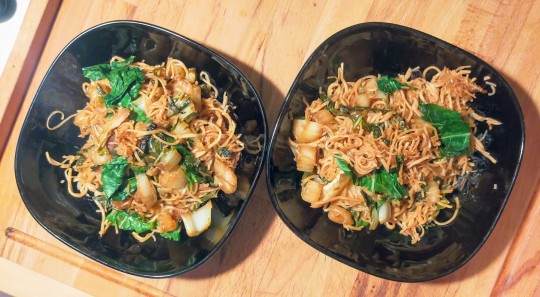
These simple Pak Choi Noddles make an easy, yet flavourful and hearty dinner. Happy Thursday!
Ingredients (serves 2):
200 grams/7 ounces egg noodles
4 cups boiling water
1 ½ tablespoon toasted sesame oil
1 thumb-sized piece fresh ginger
a large garlic clove, minced
half a red chili pepper
a large, beautiful pak choi (or 2 smaller ones)
1 tablespoon rice vinegar
2 tablespoons soy sauce
2 tablespoons sweet soy sauce
Place egg noodles in a medium bowl. Cover with boiling water, and place a lid on top. Allow noddles to cook, about 5 minutes.
Meanwhile, in a large wok, heat toasted sesame oil over medium-high heat.
Peel ginger, and cut it into very thin slices. Add to the wok, and fry, a couple of minutes. Add garlic, and cook, 1 minute more.
Thinly slice red chili pepper, and stir into the wok. Cook, a couple of minutes.
Thoroughly rinse pak choi under cold water.
Cut off and discard the bottom of the pak choi, and cut off the leaves, reserving for later. Chop white part of the pak choi, and stir into the wok. Cook, coating in oil and spices, about 5 minutes.
Deglaze with rice vinegar, soy sauce and sweet soy sauce.
Drain cooked egg noodles, and rinse under cold water. Set aside.
Stir half of the reserved pak choi leaves into the wok, and cook until just wilted. Then, stir in drained egg noodles, and remaining pak choi leaves, coating well in the sauce.
Serve Pak Choi Noodles hot.
#Recipe#Food#Pak Choi Noodles#Pak Choi Noodle recipe#Noodles#Noddle recipe#Pasta and Noodle#Egg Noodle#Pak Choi#Fresh Pak Choi#Sesame Oil#Toasted Sesame Oil#Ginger#Garlic#Red Chilli#Red Chilli Pepper#Chilli Pepper#Rice Vinegar#Soy Sauce#Sweet Soy Sauce#Quick recipe#Easy recipe#Thrifty#Thrifty recipe#Vegan Noodles#Vegan recipe#Vegetarian and Vegan#Thai Lao Japanese Chinese Chufang#Asian Cuisine
17 notes
·
View notes
Text
You ever make food that tastes so good and you fully didn't expect it to. I just made some pasta and said "holy shit" out loud at my first bite.
#what I did was steam/boiled pak choi and spring onions in vegetable stock I had left over from the last time I did that. added some fresh#lemon juice and a bit of olive oil and some parmesan#and that's it#crying in the club
43 notes
·
View notes
Text
planted a fresh garden out back today! parsley, spring onion, carrots, spinach, pak choy annnnnd some pansies too :3 I am looking forward to meeting these new friends if they grow! fingers crossed!
52 notes
·
View notes
Text
I put a fairly chunky fresh salmon fillet in to marinade in gluten free teriyaki sauce last night and I have some pak choi, nori sheets and rice as well, but I'm not quite sure how to assemble these ingredients into the dish I'm thinking of in my head.... any ideas?
(Bed of rice, teriyaki salmon, then pak choi on the side with sesame seeds and chopped up nori on top like garnish? Yes? No?)
Times like this make me wish I had Hannibal on speed dial so I could ask him for help; he'd know exactly what I'm thinking of and make it for me before I even think to ask him.😂
#i nearly cried last night when I found GP teriyaki marinade because that used to be one of my FAVOURITE flavours pre-diagnosis#it's been 8 years since I got to have teriyaki so i'm really excited for dinner tonight hhhh#tw; meat
17 notes
·
View notes
Text

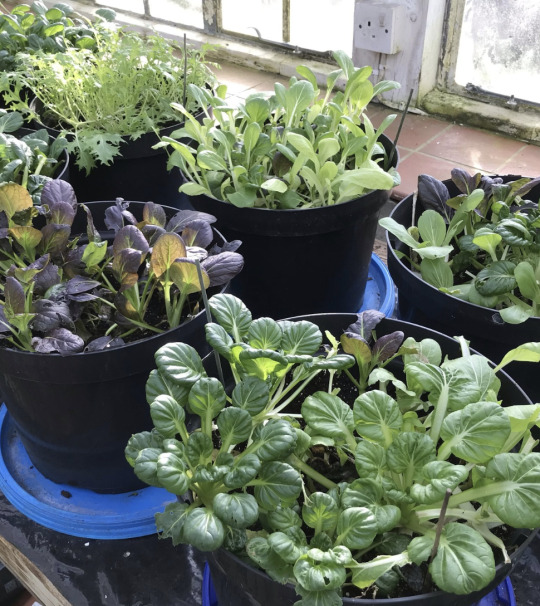

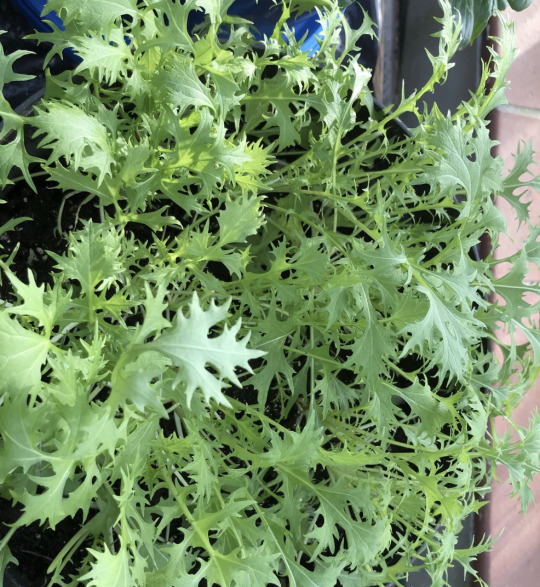
Did you know that certain types of salad plants can be grown year round here in southern England? This is our "leaf table" in the ye olde greenehouse, which supports a variety of fresh tasty salad plants during the winter. By keeping the plants in a greenhouse, they are protected from frost and intense rains. The green "curtains" in the corner are agricultural cloth blankets we place over the pots on the coldest nights. The south-facing side of the greenhouse receives maximum light and warmth on short winter days, helping the plants maintain a slow but steady growth rate. Unfortunately, due to the short day lengths and low temperatures, the plants grow much slower than in the spring and summer so we must harvest them conservatively.
Some garden plant species I recommend for winter salad cultivation are shown in the photos following the main view of the table.
Tat Soi (Brassica rapa var. rosularis) and Pak Choi (Brassica rapa subsp. chinensis). The Tat Soi are the dark green plants with rounded leaves and the Pak Choi are the plants with oval pale green leaves. Both of these East Asian traditional cabbage varieties can be allowed to mature into large plants or picked regularly to keep them small.
Komatsuna (Brassica rapa var. perviridis). This petite cabbage variety comes from Japan and has a crunchy texture.
Mizuna ( Brassica rapa var. niposinica). I was surprised that the spiky Mizuna is the same species as the other leaves. Unlike the mellow leaves, it has a spicy arugula-like flavour. I recently learned that Mizuna is among the plants astronauts have grown on the International Space Station!
Our final plant is NOT a Brassica rapa! This plant is called Miner's Lettuce (Claytonia perfoliata). This dainty plant comes from mountain and coastal regions of North America and Central America, and is named because gold miners in California ate this plant to prevent scurvy, a vitamin C deficiency disease.
#katia plant scientist#botany#plant biology#plants#plant science#greenhouse#gardens#gardening#grow your own food#grow your own#lettuce#mizuna#tat soi#bok choy#asian greens#leafy greens#salad#winter#winter garden#green academia#potted plants#indoor garden#indoor farming#healthy eating
14 notes
·
View notes
Link
Astronauts on board the International Space Station are often visited by supply ships from Earth with food among other things. Take a trip to Mars or other and the distances are much greater making it impractical to send fresh supplies. The prepackaged food used by NASA loses nutritional value over time so NASA is looking at ways astronauts can produce nutrients. They are exploring genetic engineering techniques that can create microbes with minimal ingredients. Many of us take food and eating for granted. The food we can enjoy is usually flavoursome and the textures varied. Astronauts travelling through space generally rely upon pre-packaged food and often this can lack the taste and textures we usually enjoy. Lots of research has gone into developing a more pleasurable dining experience for astronauts but this has usually concentrated on short duration trips. The space station’s Veggie Facility, tended here by NASA astronaut Scott Tingle, during the VEG-03 plant growth investigation, which cultivated Extra Dwarf Pak Choi, Red Russian Kale, Wasabi mustard, and Red Lettuce and harvested on-orbit samples for testing back on Earth. Credits: NASA During longer term missions, astronauts will have to grow their own food. Not only due to the nutritional issues that form the purpose of this article but carrying prepackaged food for flights that last many years becomes a logistic challenge and a launch overhead. To address the loss of nutritional values, the Ames Research Centre’s Space Biosciences Division has launched its BioNutrients project. The team has announced they has come up with a solution, thanks to the wonders of genetic engineering. The approach that the team has developed involves microbial based food (similar to yeast) that can produce nutrients and compounds with small amounts of resources. The secret is to store dried microbes and take food grade bioreactors along on the trip. Until now I never knew what a bioreactor was nor that they even existed. I live in the world of physics and astrophysics so this concept intrigued me. Turns out that a bioreactor does just what it says. It is a container of some form, often made from steel) inside which, a biologically active environment can be maintained. Often chemical processes are carried out inside which involve organisms undergoing either aerobic or anaerobic processes. They are often used to grow cells or tissues and it is within these that NASA pins their hopes on cultivating food in space. Even years after departure, the dried out microbes can be rehydrated many years later and cultured inside the bioreactor, creating the nutrients astronauts need. To date, the team has managed to produce carotenoids (a pigment found in nature) which are used for antioxidants, follistatin for muscle loss and yogurt and kefir to keep the gut in good health. The real challenge though is making food that the astronauts will want to eat. Source : BioNutrients Flight Experiments The post Astronaut Food Will Lose Nutrients on Long-Duration Missions. NASA is Working on a Fix appeared first on Universe Today.
2 notes
·
View notes
Text
I’m cooking tarragon chicken right now and I’ve been meaning to share the recipe for ages so buckle up cause here it comes.
This is my friend’s family recipe (I think), and the first time I had it was when I was homeless and living in their spare room, and since then it’s become one of my top comfort foods - it’s great for winter but works in summer too, and depending on how many of you you’re cooking for can work for multiple day’s food.
you’ll need:
Skin on chicken thighs - I get them in packs of 7/8 and that will last my dad and I dinner for two nights, or dinner one night and next day’s lunch.
Prefered cooking oil - I recommend olive, but whatever you usually use would probably work
125ml white wine - that’s a 6th of a bottle for those of you who don’t drink. This is going to be used to deglaze the pan - you could probably get away with making some quick chicken stock with stock cubes and using those, but I promise the wine makes it good. It doesn’t need to be a great wine, but don’t go with the cheapest bottle, either (if you don’t drink, I recommend finding a friend/neighbour who does)
Juice of half a lemon
500g ripe cherry tomatoes
Fresh tarragon
salt and pepper - I personally like the chunky salt and freshly cracked black pepper, but anything will do in a pinch
Wild rice (or rice of your choice)
pak choy/carrots/green beens/whatever vegetables take your fancy
1. preheat oven to 190ºC/gas 5. Season the chicken with salt and pepper, heat the oil in a large frying pan or saute pan on a medium high heat and sear the chicken, turning the pieces several times until golden brown all over.
2. transfer the chicken, skin side up, into a casserole dish.
3. Deglaze the pan with the wine. That link there will teach you how to deglaze a pan - it’s super simple, and I promise it makes all the difference.
4. pour the liquid from the pan into the dish along with the chicken, add the lemon juice and a pinch of salt and pepper, then cover with foil and place in the oven for 30 minutes.
5. whilst it’s in the oven for the first time, prep any vegetables you’re serving with - I like to do grilled pak choy and buttered carrots, but it’s really up to you.
6. After 30 minutes remove from the oven and remove the foil - top tip, you can reuse that foil to line the tray you cook any vegetables on. Add the tomatoes, making sure not to cover the chicken - you want the oven to crisp it up a little - and replace in the oven without the foil for 25 minutes.
7. rinse the rice and cook (i’m not great at rice, so just cook it how you normally would)
8. cook the accompanying vegetables to your liking.
9. remove the casserole tray from the oven, add a couple of sprigs of tarragon and let rest for five minutes. Meanwhile rinse the rice again with boiling water.
10. Just before serving, add another handful of tarragon leaves to the dish.
11. Ta Da! you have a hearty meal! I recommend serving with.a spoonful or two of the liquid in the casserole dish - it moistens the rice and ties everything together.
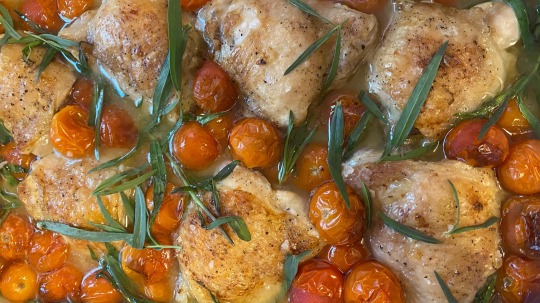
9 notes
·
View notes
Text
Hi, yesterday was a frustrating day. I live at home with my parents and my younger sister. (#4)
My relationship with my parents is difficult, our personalities clash a lot and there not much trust between us. Growing up, home life was always difficult. No money, four kids, parents always working. Stress levels was HIGH.
My mum is the perfect manipulator and gaslighter. She would purposely make us feel bad and then play the victim when we would stick up for ourselves. Which then her behaviour would change and would become so passive aggressive. Leaving us walking on eggshells around her and never really trusting her because we never knew how she would react.
On the other hand, my dad was always at work. Working 2 jobs, day and night, means I never really got to see him so I having a bond with him was difficult. I can’t be mad at the situation because he was the reason we had food in our belly’s. When he was home, he was tired and if we did something that he didn’t like - he was explosive. An angry man. Just very aggressive and with his explosive behaviour, we couldn’t trust him because we were walking around on egg shells.
As we’ve gotten older, my dad is less aggressive but now really defensive and my mum is in charge of everything. If she doesn’t like something, he will kick off about it. But about 2 years ago, my dad cheated on my mum. It was during the 2nd lockdown when we all found out and having to live in the same space as them was traumatic. There was no escape from them.
That’s why it’s hard to trust them.
Nothings ever been worked out, we all just ignore it and try carrying on. Me and #4 do not get involved. It’s not our relationship, therefore don’t bring us into it. We had to become their therapist and quite frankly, we are done with it.
I’m never really home but when I am, I’m constantly cleaning up their mess around the house. I don’t mind, because it keeps me busy but some of their mess makes no sense so I get frustrated. I’m organising everything and just getting angry because what they think makes sense, doesn’t in fact make sense. So I’m questioning “why!?” - All the time.
Yesterday, I was organising the fridge. My dad is the one that cooks but he is a mess. He makes a mess. Nothing in the kitchen makes senses. So I reorganised the fridge this time because it was a mess. Everything was on top of everything. It was salmonella’s wet dream of cross contamination.
This is when I saw that we have some pak Choi about to go out of date and I was like “what a perfect time to make something fresh, healthy and from scratch.” I wasn’t at work and I looking cooking so I was excited.
I called my sister #1 about what to cook, that I can incorporate pak Choi and her and her partner suggested chok which is a rice porridge/soup dish. Super easy, super cheap and super exciting to make. She gave me a bit of ginger and I literally had everything else at home to make it with.
I steamed all my vegetables and made the chok and it was really nice. Not my favourite thing I’ve made but it was still really nice. Everything tastes better when you’ve made it though. And I cooked it for everyone to have for tea. Everyone is always going on how they want something new and healthy to try and I’ve literally just made it.
When my mum finished work, we saw sister #2 and her baby ( lil cutie ) and on the drive back my mum was like “ohh what should we have for tea?”
“I’ve already made tea for everyone” I said in the back of the car. “I made it all from scratch, you should at least try it. I got the recipe of #1 and her partner”
“Eww noo, I don’t want that, I want some proper food” she replied back.
I replied back with silence.
I was so angry and upset that no one wanted to eat what I made them. They drove to Tesco’s and picked up some pizza for themselves and that only upset me more. When we got home they cooked it immediately and left food on the side. My mum was like “ohh help yourself, there’s loads left over” which translated to me that what I cooked wasn’t real food. They didn’t even try it. I was just like “I’ve already eaten mum, I don’t need more food.”
To be so excited to cook something for everyone, to have it all thrown back in my face, I was so frustrated. To know that I tried and no one wanted to even taste it literally just broke my heart. I was angry because it was such a waste and it was so ungrateful of them.
My dad makes some atrocities in the kitchen and we still have to eat it. Force fed in all fairness because we get guilt tripped into it because “it’s wasteful” and it’s “ungrateful” because“ I just spent ages cooking that” so “you will eat it”. Hypocrites! That’s what angered me the most. The hypocrisy of them frustrated me to the point I couldn’t even look at them, there was no need for any of that, and then they waste their money on frozen pizza!?
What hurts most, is that I tried to do something nice for them. The gesture was never even taken into consideration either. Not even “Thanks for cooking for us, but we’re going to have something else”. No. Wasn’t even recognised. It really makes me question why I even try. I said to #4 that it was the last time I’m going to do anything for them but I know I was lying.
Our relationship is difficult, but I try and they don’t so what am I supposed to do?
#blogstory#diary entry#diaryposting#blogs to follow#dear diary#daily diary#comfort food#asian food#parents#family#tw depressing stuff#family problems#it's difficult
2 notes
·
View notes
Text
copied her recipe to here for easy access:
Noodles - ramen noodles, udon noodles, or even just cheap packet noodles will all work a treat here Smooth peanut butter @manilife_ (or any nut butter you have in your cupboards) Miso paste - I used @yutakaeats white miso paste but any will work Sesame oil 1 tsp grated ginger 1 tsp grated garlic Chilli flakes Veg stock + optional soy sauce 200ml coconut milk Pak choi Chilli oil @verylazyfooduk Toppings include: fresh coriander, charred sweetcorn, diced spring onion & sesame seeds
Recipe:
Gently fry garlic, ginger and a sprinkle of chilli flakes in a little sesame oil - normal olive oil is also fine.
Meanwhile mix together 1-2 tbsp nut butter and 1 tbsp miso paste, loosen with a little hot water to make a smooth consistency.
Add paste to the pan and slowly mix with a little hot water until a loose consistency, then add coconut milk and some extra hot water, so you have enough ramen stock for your servings and to cook the noodles in. Be more generous with the liquid than not so you have a soupy ramen, and just make sure to keep testing and season to taste accordingly.
Pop in a veg stock cube. Then season to taste with an optional extra dash of sesame oil + soy sauce etc if needed.
Add noodles and pak choi to the liquid and cook for 3 to 5 ish minutes or until ready.
Serve in to bowls with a generous drizzle of chilli oil and optional garnishes!

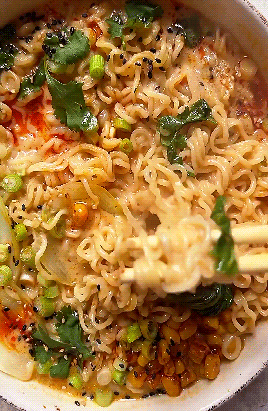
Creamy Peanut Miso Ramen (x)
3K notes
·
View notes
Text
Top 8 Bok choy (Chinese cabbage) Nutrition facts and Health benefits
Selection and storage Although bok choy can be available year-round, it is at its best during the winter season. In the markets, buy fresh harvest featuring firm stalks and dark green crispy, flavorful leaves. Avoid slump plants with leaves wilted and lost their luster. Once at home store whole pak choi (bok-choy) in a vegetable compartment inside the refrigerator, set at high relative humidity.…
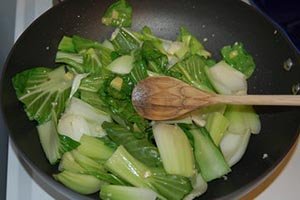
View On WordPress
0 notes
Text
Pak Choi Ramen (Vegan)
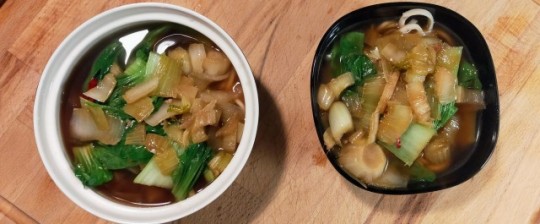
Fragrant and spicy, a steaming bowl of these Pak Choi Ramen is a delicious way to warm up on a rainy day! Happy Monday!
Ingredients (serves 2):
1 1/2 tablespoon toasted sesame oil
1 thumb-sized piece fresh ginger
a large garlic clove, minced
half a red chili pepper
2 beautiful pak choi
1 tablespoon soy sauce
1 tablespoon sweet soy sauce
1 tablespoon Nuoc mam (fish sauce)
3 cups water
60 grams/2 ounces dry ramen noodles
1 tablespoon demerara sugar
In a large wok, heat toasted sesame oil over medium-high heat.
Peel ginger, and cut it into very thin slices. Add to the wok, and fry, a couple of minutes. Add garlic, and cook, 1 minute more.
Thinly slice red chili pepper, and stir into the wok. Cook, a couple of minutes.
Thoroughly rinse pak choi under cold water.
Cut off and discard the bottom of the pak choi, and cut off the leaves, reserving for later. Chop white part of the pak choi, and stir into the wok. Cook, coating in oil and spices, about 5 minutes.
Deglaze with soy sauce, sweet soy sauce, and Nuoc Mam. Stir in water, and bring to the boil.
Once boiling, stir in the ramen noodles. Cook, 3 minutes.
Stir demerara sugar into the wok, until dissolved. Allow the noodles to simmer, a couple of minutes more.
Finally, stir in reserved pak choi leaves, and cook until just wilted.
Serve Pak Choi Ramen hot.
#Recipe#Food#Pak Choi Ramen#Pak Choi Ramen recipe#Ramen#Ramen recipe#Ramen Noodles#Pasta and Noodle#Sesame Oil#Toasted Sesame Oil#Ginger#Fresh Ginger#Garlic#Hot Chili Pepper#Chili Pepper#Pak Choi#Soy Sauce#Sweet Soy Sauce#Nuoc Mam#Water#Demerara Sugar#Vegan Ramen#Vegan#Vegan recipe#Vegetarian and Vegan#Meatless Monday#Soup and Stew#Asian Cuisine#Thai Lao Japanese Chinese Chufang
12 notes
·
View notes
Text
Noodle soup
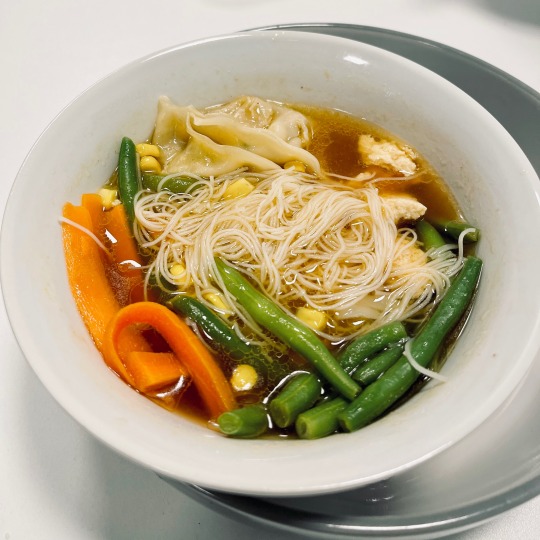
Contents of soup
I make sure that I have plenty of veg, plus noodles and protein. Some ideas of what to add:
Vegetables (frozen or fresh)
Carrot batons
Green beans
Sweetcorn
Peas
Mushrooms
Onions
Pak choi
Spring onions
Broccoli
Protein
Tofu
Gyoza
Egg
Cooked meat (make sure to reheat thoroughly)
Noodles
Vermicelli noodles (half a nest) - recommended, these cook the quickest
Flat rice noodles
Egg noodles (half a nest)
Arrange them nicely in a bowl that is large enough to also add the broth.
My fillings of choice are usually:
Carrot batons (frozen)
Green beans (frozen)
Sweetcorn (frozen)
Gyoza (frozen)
Tofu (frozen)
Vermicelli noodles
Soup!
To be made separately. I find it easiest to put the ingredients in an empty spice container or small plastic container and shaking it vigorously over a sink. You can also add it to a separate bowl and mix thoroughly.
Once the soup base is made, pour it evenly over the contents of your ramen.
Now put the bowl on top of a small plate. This is so you can take it out the microwave easily.
Fill the bowl with boiling water to a comfortable level. Don't fill it too close to the top, otherwise it will be difficult to take it out the microwave.
Give the soup a good mix.
Microwave the ramen for 3 minutes on high. You want to make sure that the frozen veg is cooked through and the broth is hot. If this is not the case, perhaps because you used frozen vegetables, stick it back in the microwave for 3 minutes.
Thai-inspired soup
3 heaped teaspoons Thai curry paste (red or green)
2 heaped teaspoons coconut cream
Half a stock cube (I usually use vegetable)
2 level teaspoons lemon juice
1 tablespoon soy sauce
1 teaspoon ginger
1 teaspoon garlic powder
1 tablespoon sriracha (optional, spicy)
Japanese-inspired soup
3 tablespoons Vegetarian Oyster Mushroom Sauce
2 tablespoons sesame oil
1 teaspoon rice wine vinegar
1 teaspoon ginger
1 teaspoon garlic powder
0 notes
Text
Here are some ways to maintain a healthy gut microbiome:
Eat a variety of fresh foods
Eat a range of whole foods from plant sources, including fruits, vegetables, legumes, beans, nuts, and whole grains.
Eat foods that promote gut health
Eat foods high in fiber, like oatmeal and beans, and foods that contain phenols, like blueberries, red peppers, and purple cabbage.
Eat probiotic foods
Eat foods that contain probiotics, like fermented milk kefir, sauerkraut, tempeh, and miso.
Eat prebiotic vegetables
Eat vegetables that contain prebiotics, like bananas, fennel, asparagus, cold potatoes, onions, garlic, leeks, Jerusalem artichokes, and pak choi.
Eat red wine
Red wine contains polyphenols, which support beneficial bacteria in the gut. You can also eat fresh berries or dark chocolate to get the same polyphenol benefits
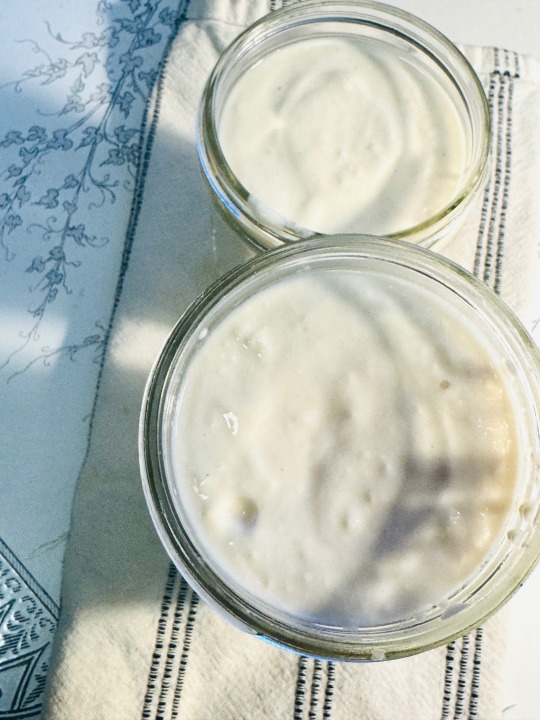
I made Soy yogurt. Silk vanilla, organic soy milk and 3 Jarro acidophilus vitamins opened into the instapot. 15 hours later. Yogurt
0 notes
Text
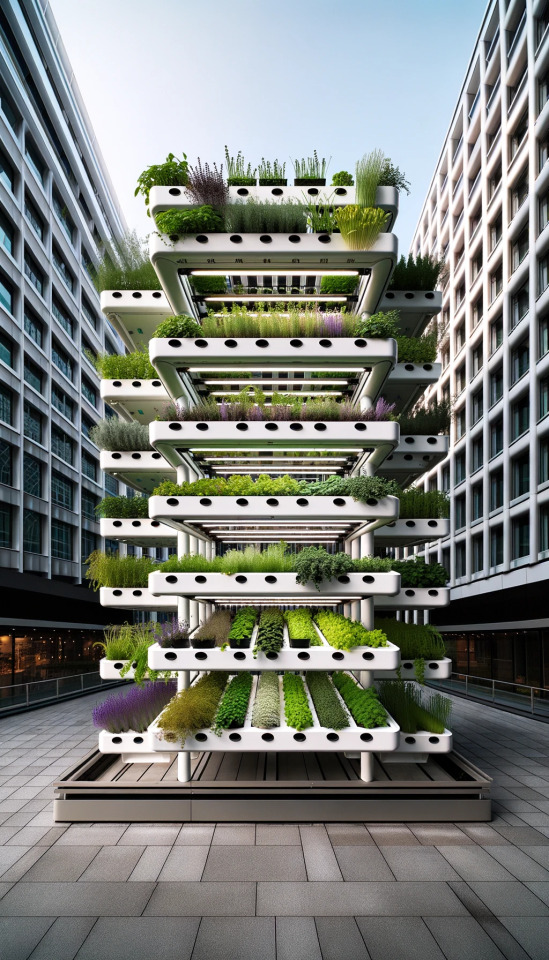
Aquaponics Plant Choices
Environmental Impact of Aquaponics
Aquaponics' Impact on the Environment:
Aquaponics is a sustainable food production method that positively affects the environment when done at home. Let's explore how aquaponics contributes to eco-agriculture and resource conservation.
Environmental Impact of Aquaponics Compared to Traditional Farming:EffectHome AquaponicsTraditional FarmingCarbon FootprintMinimalHighWater UsageDrastically ReducedA Lot of waterways destroyedOverfishingPreventedHigh bycatch ratesDeforestationPreventedTo build farmlandTransportationMinimalOther parts of the worldSingle-use PlasticAlmost noneEvery product in multiple wrapsFood LeftoversFed to Fish and Fertilizer for PlantsEnd up in LandfillsResource ConservationMostNone
Unique Details:
Aquaponics not only reduces carbon footprint and water usage but also prevents overfishing and deforestation. Plus, transportation requirements are minimal, which lowers emissions, fuel consumption, and single-use plastic. Also, aquaponics significantly reduces food waste because it keeps growing instead of getting bad if you don’t eat your food.
Suggestions:
To maximize aquaponics' environmental impact:
Use renewable energy sources to power systems, reducing carbon emissions even more, like synchronizing LED lights and heating with wind or solar energy.
Install rainwater harvesting systems to minimize water consumption and increase sustainability by increasing the local water cycle.
Promote responsible fishing practices globally to protect aquatic ecosystems beyond the scope of aquaponics.
Keep researching and improving your system to make it more efficient and less resource-intensive.
By taking these steps, we can ensure that aquaponics remains an eco-friendly option, promoting sustainable food production for years to come. Aquaponic gardening – where fish live in synergy with plants. Filter water and recycle nutrients in one convenient waterbed or in multiple vertical farms! Let your creative mind play.
Benefits of Aquaponic Gardening
Aquaponics - Reap the Benefits of Sustainable Farming!
Organic Produce: Grow chemical-free fruits and veggies.
Water Conservation: Use much less water than traditional farming.
Eco-Friendly Agriculture: Create a self-sustaining ecosystem.
No pesticides or antibiotics are needed. Plus, you can recycle leftovers and make use of black soldier fly larvae. This holistic approach creates optimal growth and minimal waste.
Enjoy organic produce, conserve water, and contribute to eco-friendly agriculture with aquaponic gardening! Start your journey today! Remember: Selecting the right plants is key - plants are great listeners!
Types of Plants Suitable for Aquaponics Systems
Are you searching for a sustainable way to cultivate food? Aquaponics provides an environment-friendly answer fitting your home, garden, or backyard. You'll be astonished at the range of plants you can grow with aquaponics - from herbs to leafy greens to vegetables. To discover more about your aquaponics plant options, peruse this article.
Certain plants are ideal to cultivate in aquaponics. They love the watery environment and help the system to work well. Many of the things you grow can also be fed to the fish if you don't like it or it's old or brown or something like that. Another factor that many people like about aquaponics is that the leaves grown are softer and crispier than supermarket produce because it's fresh and not dead and decaying.
You can argue with me, but I think it's possible to grow any plant in aquaponics if we just create the right conditions by playing around with substrate, flooding frequency, fish feeds, grow bed size, and many more factors.
Here are some ideas for you to grow:
Leafy Greens:
Leafy greens are perfect for carnivore and omnivore aquaponics fish.
Lettuce
Spinach
Kale
Arugula (Rocket)
Cucumbers
Bell Peppers
Tomatoes
Broccoli
Radishes
Bok Choy (Pak Choi)
Swiss Chard
Mustard Greens
Collard Greens
Endive
Escarole
Watercress
Romaine Lettuce
Butterhead Lettuce
Iceberg Lettuce
Red and Green Leaf Lettuce
Fruiting Plants:
Fruiting plants thrive in aquaponics with omnivore and more herbivore fish.
Strawberries
Blueberries
Raspberries
Blackberries
Dwarf Melons
Dwarf Watermelons
Figs (with appropriate pruning)
Grapes (trellised)
Passionfruit
Dwarf Banana Plants
Tomatoes
Peppers
Cucumbers
Aquaponics Compatible Plants:
Aquaponics plants that thrive in nutrient rich water.
Watercress
Water chestnuts
Taro
Vietnamese coriander
Water spinach
Root Crops:
Root crops require nutrient rich water.
Carrots (shorter varieties work best)
Beets
Turnips
Radishes
Onions (especially green onions)
Flowers:
Enhance the beauty in your life.
Marigolds
Violets
Pansies
Petunias
Sunflowers
Medicinal Plants:
Treat diseases naturally.
Aloe Vera
Chamomile
Lavender
Echinacea
Lemon Balm
Others:
Some other ideas for your aquaponics system.
Green Beans
Peas
Okra
Brussels Sprouts
Cauliflower
Lots of Plant Varieties: Aquaponics offers lots of different plants. From leafy greens to fruiting crops to exotic herbs.
For those seeking unique aquaponic plants, consider amaranth and chili peppers.
Sarah, in a small coastal town, began aquaponics with leafy greens. Soon, her lettuce beds inspired others to experiment with different plants. The town united to grow a wide range of edible plants in aquaponics. This changed their food and living landscape and gave them more self-sufficiency. Aquaponics sparked personal and community growth.
Inspire other’s to start growing by making them jealous of your home jungle.
It is clear that aquaponics integrated with vertical farming holds great potential for sustainable and effective food production.
A study showed that aquaponic systems can harvest up to ten times more produce than traditional soil-based methods!
Aquaponic Herb Gardens
Aquaponics Herb Selection!
The aquaponics system is known for its amazing relationship between fish and plants. It's the ideal environment to grow many different culinary and medicinal herbs. Here's a list of the most common herbs that grow in aquaponic systems:
These herbs boast unique flavors and aromas, plus health benefits.
To get the best herbs from your aquaponic system, remember these tips:
Manage pH properly. This ensures nutrients will be absorbed and plants stay healthy.
Control the temperature. Monitor and regulate the water temperature within the ideal range.
Give herbs the correct lighting. Make sure they get enough sunlight or use artificial lighting.
Supplement with essential nutrients. Do this occasionally to maximize growth and nutrition.
Pick the right herbs and use these suggestions, and you'll have a vibrant herb garden full of flavorful produce!
Plant Growth Rate in Aquaponics vs. Traditional Soil
Comparing growth rates, aquaponics is faster and yields more than traditional soil-based cultivation. The cyclic nature, nutrient availability, and oxygen level create ideal conditions for plants as well as fish. Automated systems are simple to build and remove the need for manual watering and feeding, keeping produce always fresh without pesticides. No extra fossil fuel fertilizer is needed either - nitrogen from fish waste feeds the plants. This sustainable practice cuts down on the unnecessary transport of fertilizer, plastic, and food.
An example of a guided automated aquaponics setup is seen here.
It's like a two-for-one deal! Veggies get supercharged nutrients from the water like SpongeBob on steroids.
Nutrient Uptake in Aquaponic Plants
Aquaponic plants absorb essential nutrients from fish waste in a symbiotic relationship. Ammonia that fish breathe out and is being released during the decay of organic matter can directly be absorbed through diffusion and converted to ammonium, instead of oxidizing ammonia to nitrate, which the plant has to reduce to ammonium first to make amino acids. These plants are key to sustaining water quality and growing both fish and plants. Lettuce, basil, and mint absorb nitrogen, phosphorus, potassium, and iron. Acidification can arise over time from breakdown of fish waste, so rock dust can be used to raise pH levels and create an optimal environment for plants. Don't forget to mix up your plant varieties for an efficient system with improved productivity. Get creative with your aquaponic plant choices now! Oh, and don't worry - pH levels won't cause any arguments like some couples do!
Also, check our nutrient and fertilizer deep dive guide to master the elements.
The Role of pH in Plant Growth
The influence of pH on plant growth is massive. Its balance affects the alkalinity of water, pH readjustment, and nutrient availability - all impacting the health and productivity of plants. Different plants thrive in acidic and alkaline conditions, so it's important to understand and maintain the right pH levels for growth.
A table shows four key factors related to pH in plant growth:
Water alkalinity: determines water suitability for plant growth.
pH adjustment: helps maintain ideal pH levels for different plants.
Nutrient availability: affects the absorption and use of essential nutrients by plants.
Acidic vs. Alkaline: different plants prefer different pH conditions.
It's also significant to know that individual plant species or cultivars have varying preferences for acidic or alkaline environments. Regular monitoring and adjustments can optimize nutrient absorption.
Sounds very complex and scientific but plants and fish are also adaptable so don’t overcomplicate it. Just learn and allow yourself to make some mistakes by setting up a small aquaponics system.
An interesting fact from history is that ancient civilizations knew soil fertility was important and experimented with ways to get it. They were aware that adjusting soil acidity could increase crop yields - showing that pH's role in plant growth has been recognized for centuries. Finding disease-resistant aquaponics plants is like seeking a mythical creature!
Disease Resistance in Aquaponics Plants
Tomatoes and basil are less prone to diseases since they have high resistance. Bell peppers, however, need more attention to prevent diseases.
Pest management is also key. A balanced ecosystem with pest predators helps control them naturally, without using any chemical pesticides. This way, the produce improves its taste and quality.
One of many plant's defense mechanisms is with chemical substances to defend from pests and predators increasing health benefits and taste for us.
How You can Influence Plant Taste and Health
For example, we can significantly increase the taste by stopping watering herbs before harvest. Equally important, direct sunlight improves the plant's ability to create enzymes, vitamins, and amino acids to enhance taste. Sunlight also damages the plant, which in response, increases its defense mechanisms against UV-A, UV-B, and UV-C rays. UV-C is the most damaging, and UV-A is the least damaging. But that also means UV-C has the most energy and UV-A the least of the UV rays. LED lights can only produce light up to UV-A lights because UV-B and UV-C destroy the light-emitting diode very quickly. Rock dust increases nutrient availability, which makes it possible in the first place to produce certain plant flavors, which are also defense mechanisms against certain predators and parasites. In the plant world, parasites are the so-called pests, and they increase defense response by stimulating immunity unless the plant misses nutrients and can't produce enough or there are too many pests, and the plant dies.
A farmer experienced the advantages of disease prevention in his aquaponic farm. He used organic methods and focused on disease-resistant plants. This resulted in impressive crop yields and great taste. This success story shows the importance of disease resistance in aquaponics plants for productivity and customer satisfaction.
Plus, root systems in aquaponics are like the unrewarded heroes of the plant world. They anchor and absorb nutrients, while the fish can enjoy the waste free waters.
Root Systems in Aquaponics
Hydroponic Roots are a must for aquaponics! They ensure root oxygenation and health. Roots give stability and absorb nutrients for water-based growth. Knowing the root structure is key to keeping an aquaponic system healthy and productive.
No need for Tinder here! Fish and plants make the perfect pair in aquaponics and in the amazon rainforest.
Synergy Between Fish and Plants
The bond between fish and plants is symbiotic.
Fish waste is converted by bacteria, insects and worms. This assists aquaponics.
All the waste combined provide nutrients for plants, aiding plant growth.
The ecosystem balance is regulated by the nitrate cycle. This creates a diverse habitat, providing living space for many species.
For optimal growth, pick fish species which produce waste rich in nutrients beneficial to plants. Finding the ideal grow bed medium is like finding true love - it takes effort, but once found, it's a match made in aquaponic paradise!
Choosing the Right Grow Bed Medium
Selecting the optimal grow bed substrate for an aquaponics system requires careful consideration. Weighing the pros and cons of items such as sand, clay pebbles, perlite, gravel, small stones, lava crushes, and recycled materials like broken clay vessels or glass containers is vital for successful nutrient uptake.
These media offer unique benefits for different plant species and growth requirements. Beyond weight and surface area, other factors such as aeration, water drainage, and porosity can influence a substrate's effectiveness.
Clay pebbles, for example, have high porosity which allows sufficient airflow around roots and enough moisture for growth. Plus, recycled materials are an eco-friendly option that repurposes waste.
Also, porosity affects how well the plants absorb nutrients. Lightweight materials like perlite create air pockets within the root zone while keeping adequate moisture.
Finally, remember to give your plants enough space. Overcrowding can be a problem in aquaponics, so learn the art of plant spacing and density for the best results.
If you have can handle the weight of sand I would heavily advice you to set up a sandponics system because the anaerobic root environment creates the best nutrient-availability for the plant.
Challenges in Aquaponics Plant Cultivation
Aquaponics Plant Cultivation Challenges:
Nutrient balance: Carnivore or herbivore feed.
Pest management: Introducing pest predators.
Aeration needs: More oxygen is better.
Water quality: Too clean water won’t grow plants and too dirty water won’t maintain fish.
Cultivating plants in an aquaponics system? It ain't easy! It needs careful monitoring and maintenance at the beginning. You gotta be on top of the nutrient balance, pest management, aeration needs, and water quality.
Did you know? Aquaponics is a sustainable agriculture method. It combines fish farming and soilless plant cultivation. Imagine, vertical farming where plants can reach new heights and fish can learn to fly!
Aquaponics in Vertical Farming
Vertical Farming: An Exciting Innovation in Aquaponics!
Aquaponics, a method blending aquaculture and hydroponics, is revolutionizing vertical farming. Space optimization is achieved using vertical grow towers, allowing for high-density cultivation in urban areas. This new approach to aquaponics offers multiple advantages, like efficient resource utilization and increased crop yield.
Vertical Farming Advantages:
Space Optimization: Vertical farming makes the most of restricted space, suitable for urban settings.
High-Density Cultivation: Vertical aquaponics let you cultivate plenty of plants in a small area.
Efficient Resource Utilization: Aquaponics recycles wastewater from fish tanks to nourish the plants, minimizing water usage.
Increased Crop Yield: The controlled environment of vertical farms allows for optimal plant growth, resulting in multiple times higher yields per square meter.
Furthermore, vertical farming presents the chance for year-round crop production, regardless of weather. This steadier supply of fresh produce contributes to food security and decreases reliance on long-distance transportation. Studies have also revealed that vertical farming can reduce water consumption compared to traditional agriculture methods - a study from the University of California discovered that 95% less water was used in vertical farms while yielding similar or higher crop yields.
The Future of Aquaponics and Plant Breeding
The future of aquaponics and plant breeding looks promising! By using plant genetics and conducting research, we can maximize crop production. What's more, we can even create our own plant breeds by crossing our favorite strains.
These advancements open up a world of potential! Increased nutrient availability in water, conservation of resources, disease-resistant plants, and nutrient-dense produce. Aquaponic systems have the power to transform farming practices. Through breeding, we can boost crop quality and create varieties that are perfect for aquaponics. Don't miss your chance to join the sustainable agriculture revolution. Start exploring now!
#sustainability#environment#plasticfree#wastefree#trash#sustainable#food waste#viral#water#aquaponics
1 note
·
View note
Text
Soy caramel-glazed pork ribs
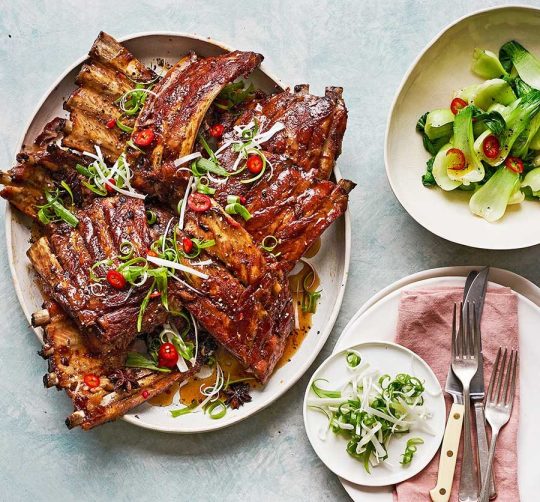
Ingredients
125ml soy sauce
1 tsp onion granules
½ tsp garlic granules
1 tsp smoked paprika
20ml apple cider vinegar
50ml Shaohsing rice wine
20g piece of ginger, peeled and finely grated
5 garlic cloves, crushed
3 star anise
1 cinnamon stick
1-2 tsp chilli flakes, to taste
1 tbsp sunflower oil
150g golden caster sugar
5kg baby back pork ribs
2 spring onions, finely sliced
pak choi, cooked white rice, sliced red chilli and pickled veg, to serve
>> Get A Free EBOOK With 101 Family Recipes that will surprise everyone! << Method:
STEP 1: Combine the soy, onion and garlic granules, the smoked paprika, vinegar, Shaohsing wine, ginger, fresh garlic, star anise, cinnamon, chilli flakes and a grinding of black pepper in a bowl. Set aside.
STEP 2: Heat the oil in a deep saucepan over a medium heat, pour in the sugar and cook, swirling the pan occasionally until the sugar has melted. Continue to cook until the sugar has darkened and caramelised. Reduce the heat to low and pour in the soy sauce mixture (it may split at this stage, but will come together again as it cooks). Turn the heat back up to medium, bring to a simmer and cook for 5-10 mins until the mixture has reduced and thickened. Remove from the heat and cool to room temperature, about 20-25 mins.
STEP 3: Meanwhile, heat the oven to 150C/130C fan/gas 2. Remove the thin membrane from the back of the pork ribs (see tip, below), then arrange them in a single layer in a large roasting tin. Pour over the soy caramel and cover the tin tightly with foil. At this stage, the ribs can be chilled for up to 24 hrs. Bake for 2 hrs 30 mins-3 hrs until the ribs are very tender and a sharp knife can be easily inserted. Remove to a plate and tip the roasting juices into a wide pan, removing the cinnamon stick and star anise. Cook the juices over a high heat for 10-15 mins until thickened and sticky. Cut the ribs into thirds, then toss in the glaze and return to the roasting tin. Heat the grill to high and grill the ribs for 5 mins until caramelised. Scatter over the spring onions and serve with steamed pak choi, rice and pickled vegetables, if you like. .............................Keep Reading.............................
1 note
·
View note
Link
🥕🥦🌽🍅 Pak Choy as a human face. 😀 Pak Choi (Pak Choy) is another great vegetable for sti- fries. 👉👉 We are growing the 2023 Sponsored Garden at Adventure 38 together! #pakchoy #gardeninspiration #garden_styles #inmygarden #shirtoftheday #foodonators
0 notes